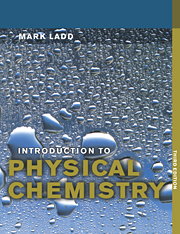Book contents
- Frontmatter
- Contents
- Preface
- Physical constants and other numerical data
- Prefixes to Units
- 1 Structure, energy, mechanism
- 2 Atoms, molecules and their structures
- 3 Determination of structure
- 4 Energy and energetics
- 5 States of matter: gases and liquids
- 6 States of matter: solids
- 7 Phase rule and properties of solutions
- 8 Chemical equilibrium
- 9 Electrochemistry
- 10 Chemical kinetics and mechanisms of chemical reactions
- Appendix 1 Problem-solving with personal computers
- Appendix 2 Stereoviewing
- Appendix 3 Average classical thermal energies
- Appendix 4 Reduced mass
- Appendix 5 Spherical polar coordinates
- Appendix 6 Gamma function
- Appendix 7 Slater's rules
- Appendix 8 Linear least squares and the propagation of errors
- Appendix 9 Determinants and cofactors
- Appendix 10 Solution of a second-order differential equation
- Appendix 11 Separation of variables
- Appendix 12 Overlap integrals
- Appendix 13 Partial derivatives
- Appendix 14 Numerical integration
- Appendix 15 Fermi-Dirac statistics
- Appendix 16 Calculation of Madelung constants
- Appendix 17 The hypsometric formula: an example of the Boltzmann distribution
- Appendix 18 Tables of physical data
- Bibliography
- Answers to numerical problems
- Index
Appendix 1 - Problem-solving with personal computers
Published online by Cambridge University Press: 05 June 2012
- Frontmatter
- Contents
- Preface
- Physical constants and other numerical data
- Prefixes to Units
- 1 Structure, energy, mechanism
- 2 Atoms, molecules and their structures
- 3 Determination of structure
- 4 Energy and energetics
- 5 States of matter: gases and liquids
- 6 States of matter: solids
- 7 Phase rule and properties of solutions
- 8 Chemical equilibrium
- 9 Electrochemistry
- 10 Chemical kinetics and mechanisms of chemical reactions
- Appendix 1 Problem-solving with personal computers
- Appendix 2 Stereoviewing
- Appendix 3 Average classical thermal energies
- Appendix 4 Reduced mass
- Appendix 5 Spherical polar coordinates
- Appendix 6 Gamma function
- Appendix 7 Slater's rules
- Appendix 8 Linear least squares and the propagation of errors
- Appendix 9 Determinants and cofactors
- Appendix 10 Solution of a second-order differential equation
- Appendix 11 Separation of variables
- Appendix 12 Overlap integrals
- Appendix 13 Partial derivatives
- Appendix 14 Numerical integration
- Appendix 15 Fermi-Dirac statistics
- Appendix 16 Calculation of Madelung constants
- Appendix 17 The hypsometric formula: an example of the Boltzmann distribution
- Appendix 18 Tables of physical data
- Bibliography
- Answers to numerical problems
- Index
Summary
An important part of the study of physical chemistry is problem-solving. This activity may range from the evaluation of a parameter from a given equation to the detailed interpretation of a set of experimental data. An involvement with numerical work conveys an understanding of the magnitudes of physical quantities. This facility is important, because computers and hand calculators produce sensible results only if they are supplied correctly with good data.
Solving numerical problems
Numerical problems give practice in relating experimental observations to theoretical models. The insertion of magnitudes into a given equation is a common scientific activity that should be mastered.
The solving of problems leads to an appreciation of several important features:
(a) the orders of magnitude of physico-chemical quantities;
(b) the need for an understanding of units;
(c) the value of checking dimensional homogeneity;
(d) the sources of physico-chemical data;
(e) the precision of the data and its transmission to the result.
Most problems involve algebraic manipulation. However, it is essential to obtain a clear picture of the physical chemistry involved in a problem before embarking on a series of mathematical processes, and it is useful to obtain an explicit algebraic expression before inserting numerical values. There are several advantages in so doing:
(f) the expression can be checked dimensionally;
(g) the possible cancellation of terms would simplify the arithmetic;
(h) similar problems with other magnitudes can be solved with little additional effort;
(i) it is good examination practice.
Information
- Type
- Chapter
- Information
- Introduction to Physical Chemistry , pp. 450 - 455Publisher: Cambridge University PressPrint publication year: 1998
